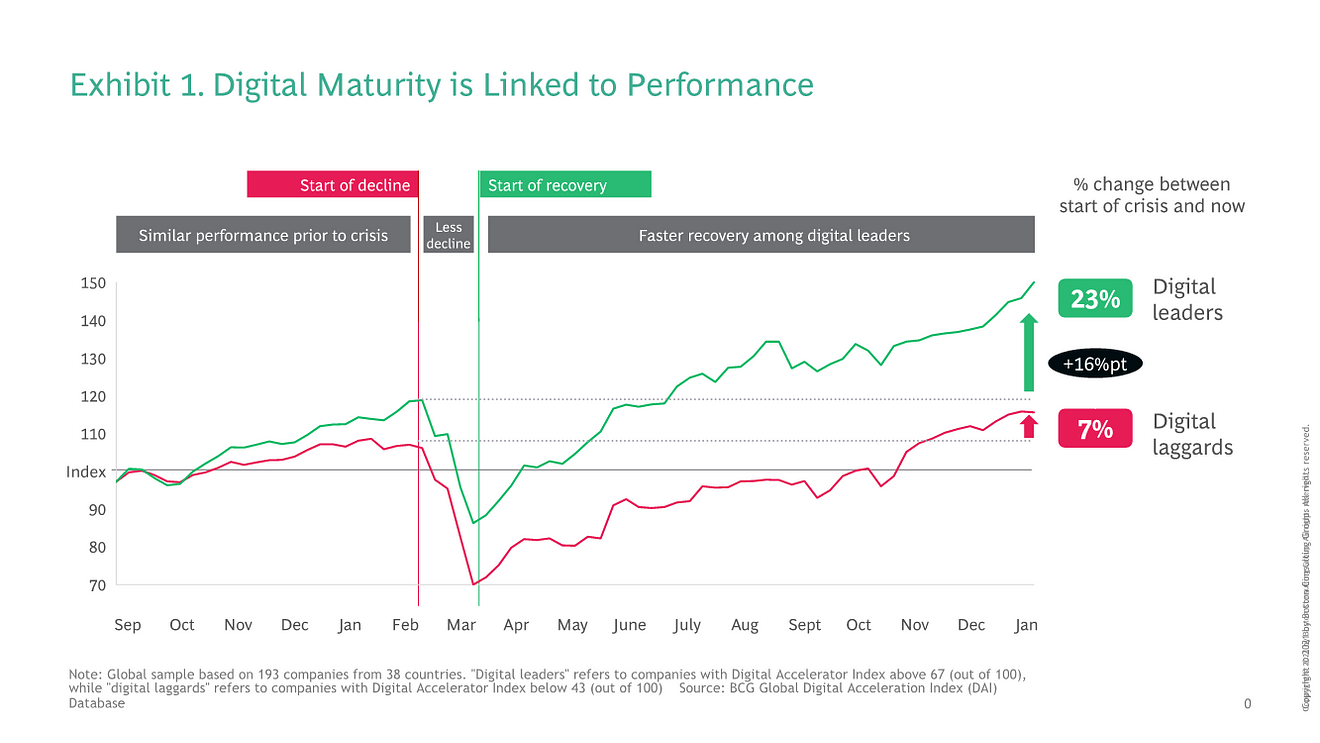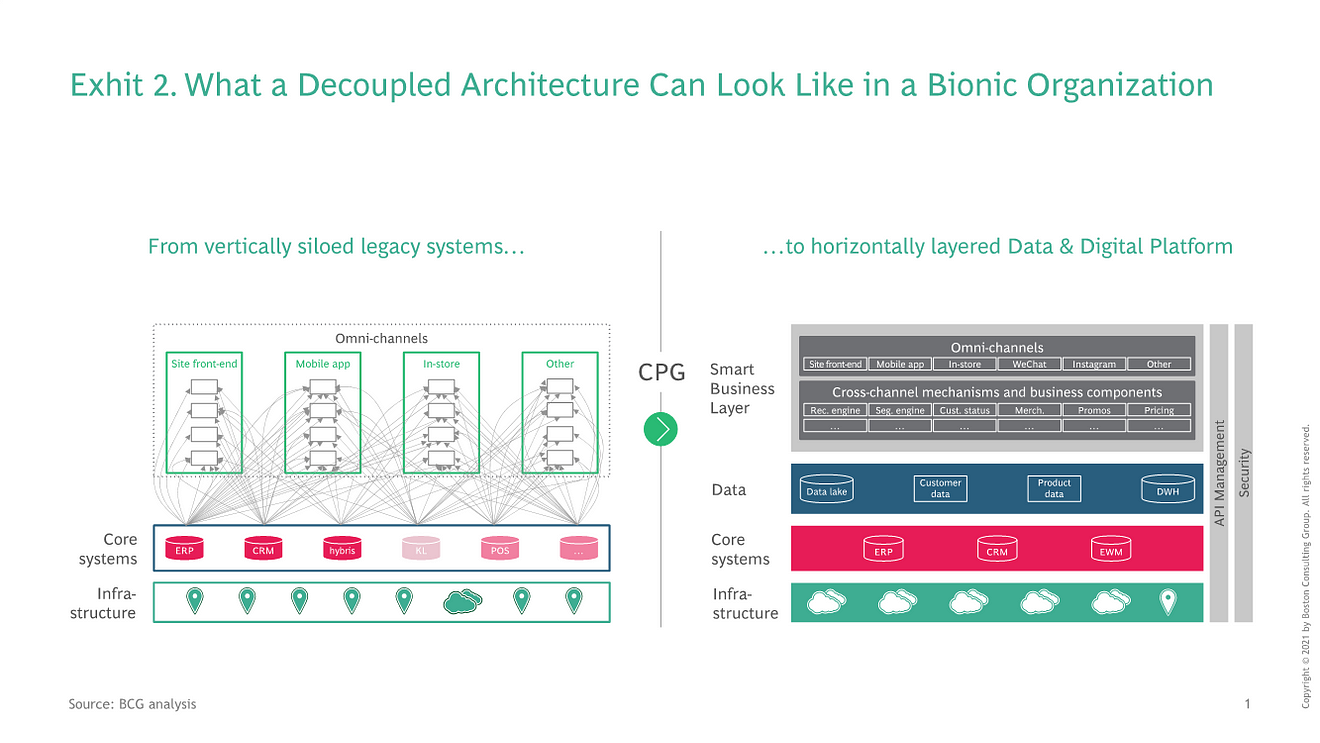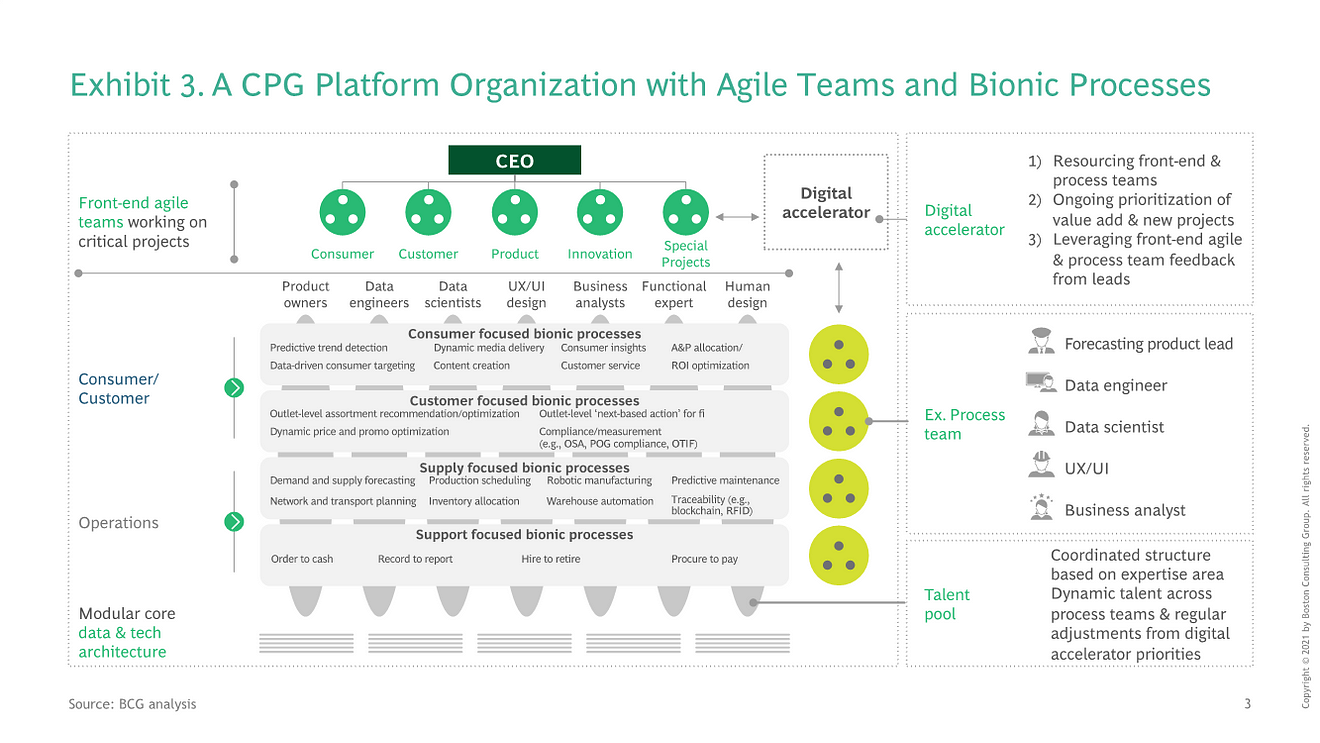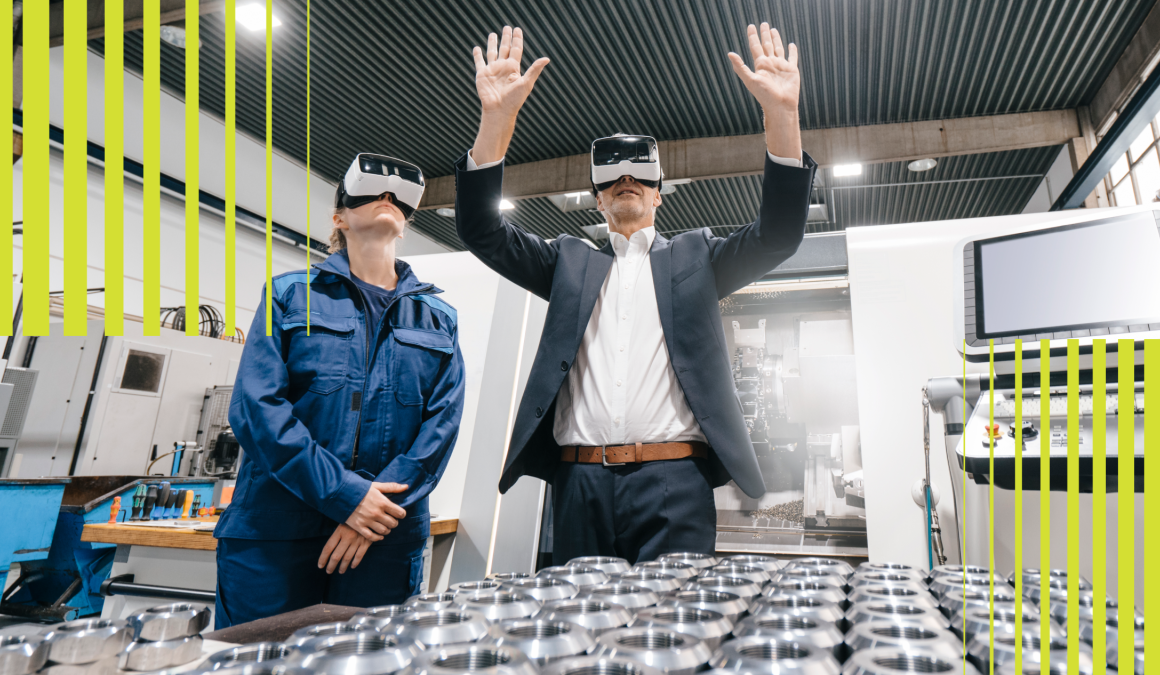BCG — Boston Consulting Group
Rich Hutchinson
June 24, 2021
There is no question that bionic companies-organizations that combine the best capabilities of humans and machines to develop superhuman strengths- outperform.
Our most recent research shows that bionic leaders on BCG’s Digital Acceleration Index (companies that score 67 or higher on a scale of 100 across 40 digital dimensions)
- increase EBITDA annually at almost twice the rate of laggards (companies that score 43 or lower), while their enterprise value rises more than twice as much each year.
- Moreover, these digitally enabled companies have outperformed peers before, during, and coming out of the COVID-19 crisis. (See Exhibit 1.)

Legacy businesses that integrate people and machines to become bionic are starting to show some eye-popping results.
- One fashion retailer used AI to improve its ordering efficiency for the next season by 25%. When it combined its AI algorithms with human insights into real-time fashion trends, ordering efficiency jumped 50%.
- Companies using bionic approaches in the insurance industry have boosted customer satisfaction to 70%, compared with 48% for digital laggards, while reducing their expense ratios by an average of 5 percentage points, compared with 1 percentage point for laggards.
- About twice as many bionic companies as digital laggards say they outpace the competition in cost efficiency, product quality, customer satisfaction, and time-to-market.
All that said, despite the substantial strides made by digital technologies and artificial intelligence (AI) in recent years, there are still relatively few bionic companies out there, and most of those tend to be digital natives.
This is because bionic is not just about the power and potential of technology.
Bionic companies require a new vision of the organization, one that people intuitively understand.
To fully unlock technology’s potential, companies need to reset the human side of their business as well, which makes refashioning bionic businesses out of legacy businesses challenging.
- Many of the elements of bionic companies, such as agile teams and modern cloud-based technology, are well known. But the formula for putting them all together is neither immediately evident nor easy to implement.
- Bionic means a fundamental change to the organization that will take time to implement. Still, with a good understanding of the bionic model-which is entirely different from how legacy companies organize-rapid progress and value creation are possible.
Here’s how bionic companies achieve their results.
- Purpose, Strategy, and Outcomes
- New Types of Organizations and Teams
- The Critical Importance of Talent
- New Leadership Models
- The Role of Data and the Tech Stack
1.Purpose, Strategy, and Outcomes
Among the handful of attributes that distinguish bionic leaders, the first is a strong sense of purpose, which energizes and aligns the organization. Microsoft’s CEO, Satya Nadella, has said, “The most useful thing I’ve done is to anchor us on that sense of purpose, mission, and identity,” which in his company’s case is to “empower every person and every organization on the planet to achieve more.”
The core competitive foundations of bionic leaders, such as value, differentiation, and advantage, are similar to those of traditional companies, but the strategies they use are digital-first. Scale is as much about access to data as it is about sales volume. The company’s position in the ecosystems that it orchestrates or contributes to is as important as the geographic location of assets. Speed of learning and the combination of humans and AI learning together become critical competitive capabilities.
Bionic companies focus on business outcomes, such as creating valuable customer experiences and relationships, developing faster, cheaper, and more productive operations, and innovating new offers, services, and business models, including those that disrupt the market and sometimes disrupt themselves. Humans work in cross-functional agile teams that are empowered to set goals and achieve them. Teams align around the common purpose and strategy so they can work with speed and agility. In truly bionic companies, 25% or more of joint business-IT teams work in this fashion.
Bionic leaders build their outcomes incrementally, proving value, then pushing for scale. They start small when changing capabilities. As with many companies, pilots and failing fast are common mantras. Bionic companies are different, though, in the attributes and organization models that allow them to achieve rapid scale-and thus transformative results. These companies have advanced technology stacks, superior digital talent, and platform organization models that enable technology to scale across a full organization instead of remaining stuck in business silos. And indeed, bionic leaders invest in technology: 55% devote more than 15% of operating expenditures to digital, compared with 29% of laggards. They invest in people-at 44% of bionic leaders (as opposed to 23% of laggards), more than 15% of the staff is in digital roles. They move quickly to scale successful pilots to end-to-end solutions (33% versus 7%).
2.New Types of Organizations and Teams
Bionic companies do not have traditional management pyramids. They replace hierarchical organizations and layers of approval with autonomous teams composed and empowered to make decisions quickly.
Bionic companies need three types of teams that are small in size (following Jeff Bezos’s two-pizza rule), cross- or multifunctional in composition, and agile in operation. The first are platform build teams, something many legacy organizations do not have. These teams are responsible for building the data, algorithms and technology, and processes to achieve the desired business outcome. Platform operating teams are responsible for operating the new bionic processes-managing pricing or the supply chain, for example. The platform operating teams have business missions and service commitments. They work toward a set of objectives and key results (OKRs) linked to the company’s strategy and goals.
In this platform-based structure, platform teams often make up 20% or more of the organization. Bionic processes are no longer owned by siloed business units-they have an organization-wide mandate. There are several reasons for this. Bionic processes require greater standardization than purely human processes. Technology is less flexible than we are. Technology requires scale to be cost effective, and AI requires mass data to train.
The platform build and platform operating teams support frontline teams that have service missions. Since they have been largely freed from having to concern themselves with internal processes, frontline teams can deliver radically improved sales, customer support, and operations.
It’s a powerful vision, but it is hard to overstate the extent of departure this type of organization represents from the traditional corporate structure. Not making the jump to new ways of working or putting in place the right organizational model are key reasons why two-thirds of digital transformations fail. Since the ability to learn new processes, leverage technology and data, and adjust rapidly based on new insights are key skills for capturing value, many companies find that a digital accelerator unit, which serves as a hub for talent and helps train people in new ways of working-can help get the transformation started.
3. The Critical Importance of Talent
In the bionic company, human talent is more important than ever, but it is a very different mix of skills than most companies now have. Necessary digital skills include data science, core infrastructure design, cybersecurity, software development, and digital marketing. Equally important are foundational skills, such as collaboration, critical thinking, creativity, emotional intelligence, and learning agility. The combination of technical and foundational skills is essential to enabling the organization to learn and innovate rapidly.
Since many employees do not have the required skills for a bionic future, the challenges of transition will be dramatic. The need for people with design and technical skills, already acute, will soar. Companies will need to pull multiple levers, including building, buying, borrowing, retraining, and automating. Bionic leaders are already emphasizing digital training and “upskilling.” Almost one-third of these companies have trained a quarter or more of their employees in such digital skills as AI and machine learning, robotic process automation, and manufacturing 4.0, compared with only 17% of laggards. To retain talent and help employees thrive, employers will have to adapt compensation and incentive programs, career path design, promotions, and talent development to the new paradigm.
4.New Leadership Models
Leadership in a bionic company must adopt four key tenets: rethink the art of the possible, move from managing to enabling, harness the full power of technology, and translate purpose into action.
The first involves setting a bold vision and creating an environment, often in the context of an ecosystem of partners, in which initiatives either fail or scale fast. Creating such an environment requires leaders to hire talent with the foundational skills described above and to train people to work with others. Continuing example-setting and behavioral nudges will be necessary to cultivate the desired culture.
Leaders have to harness the power of technology. This does not mean they must understand how every algorithm works, but they do need tech fluency so they can communicate effectively with their teams and develop a working understanding of technology’s power and limitations.
The fourth tenet-translating purpose into action-brings together the other three. Leaders must become champions of purpose-like Microsoft’s Nadella-articulating to all stakeholders what the company is trying to do and why. Leaders must also make themselves available in basic human ways, such as acknowledging mistakes (which do happen, even in bionic organizations) and acting with compassion and understanding.
When leaders embrace these four tenets, they move away from a command-and-control approach and focus on setting company goals, translating those goals into work to be done, aligning the organization, and removing roadblocks. They also play a larger role in developing team expertise and talent. They can cultivate a culture of exponential learning (at both the individual and enterprise levels) that combines human learning (individual and collective) with technical learning from training algorithms. Such a culture ultimately enables organizations to take full advantage of their bionic capabilities.
5.The Role of Data and the Tech Stack
Companies have long used technology to automate or enable processes. The bionic company goes far beyond simple the application of IT to put a modular technology stack fueled by mass data at the heart of the new organization. Bionic companies use AI to drive large-scale pattern recognition, inform predictions, enable exponential learning, and unlock the ability to make better, faster decisions. AI-powered insights enable business teams to innovate new products and design better processes, which drives competitive advantage and top-line growth.
AI requires lots of data on which to train. As companies move from a system rooted in human decision-making to one in which decisions are made jointly by humans and AI, they build up their ability to use data from multiple sources as feedstock for their advanced analytics. This requires numerous steps. The first is developing a strategic perspective on what data can be collected and what data is valuable. Next is determining how to realize the value, which is best done by identifying high-value use cases and the roadmap for realizing them.
Bionic companies make a step-change beyond traditional data governance to ensuring ready access throughout the organization to “democratized” data-data available to all-while retaining essential data privacy and security policies and procedures. Data repositories supply curated data-as-a-service. Data infrastructure-as-a-service, typically provided from the cloud, enables and automates other platform services.
Bionic companies employ modular architectures that use APIs and microservices to enable rapid assembly and reconfiguration without overhauling the entire underlying system. Unlike most legacy tech stacks, in which siloed channels draw on systems and infrastructure, a modular tech stack’s architecture is layered. (See Exhibit 2.) At the base is infrastructure, increasingly based on software, that is global and easy to program and leverages the cloud (public, private, or multi-cloud).

Next comes a core transaction layer with interoperable systems that seek to simplify transaction handling at scale and improve efficiency. Tasks include lowering risk (by reusing proven solutions) and further reducing time to market (unlocking existing functionalities). For example, companies uses SaaS and other platforms to accelerate time to market for non-differentiating digital capabilities. Traditionally, companies spend the majority of their focus and funds on this layer.
The data layer houses all relevant data in one place and unlocks AI and advanced analytics. The data layer enables increased speed and agility (developing new solutions in weeks rather than months), higher efficiency through data-driven decisions, and closer customer intimacy and engagement through an integrated single view of the customer.
At the top of the stack, the smart business layer comprises both digital enablement and cross-channel orchestration. This layer has the the AI-driven components enabled by the data layer. Digital enablement means that non-technical users can build technology applications more quickly and easily on the technology stack. Harnessing the power of technology and data moves beyond the IT function, and the speed and power of embedding it in the company increase. The smart business layer also orchestrates the customer journey across channels and ensures higher touchpoint intimacy through seamless journeys and more convenience and relevance for employees and customers.
In our experience, most companies make the mistake of focusing too much of their investment on the bottom layers of the stack. They either lack or fail to develop, mature visions of the top two layers. Bionic leaders invest first in data and smart business applications and pursue the transition to modular architecture in the infrastructure and transaction layers over time.
Bringing All Together-Bionically
How does it all work? Let’s take the consumer products goods (CPG) industry, which our research shows has the highest success rate of any major sector in digital transformation, as an example. In recent years, we have worked with several leading CPG players that have strategically deployed advanced analytics and AI with impressive gains in revenue, productivity, and the effectiveness of their marketing expenditures. They have integrated technology with the human elements of their organizations to deliver real business outcomes at scale.
These companies pursued a common approach. They picked powerful use cases at the heart of their businesses and set a mission to create valuable new processes, harnessing people and technology at scale across the entire organization. They installed digital accelerators to attract digital talent, speed the rollout of agile teams, and build the initial technology applications for critical business outcomes. Change management was essential to adapt the work of teams operating the new technology and processes. Organization design changed as they moved from decentralized and matrixed structure to the platform models that we have described and which is shown in Exhibit 3. These companies all have vital data sharing and democratized data access. They have developed a four-layer technology stack, adopted a modular technology architecture for new applications, and are retiring legacy technical debt over time.

These companies are achieving results. One global CPG player deployed an AI-driven demand-forecasting model using internal and external data to increase forecasting accuracy by 5 to 15 percentage points and optimize sourcing, production planning, and transportation and save more than $40 million. Another used advanced analytics modeling to compare ROI across brands, markets, and media channels and create a dynamic model to assess different potential scenarios for allocating spending. This model led to an increase of more than 10% in ROI on the company’s marketing expenditures during the first 12 months.
We wrote recently about how bionic companies apply the power of systems thinking to carry the bionic approach through their entire organizations. They understand that the lack of one or more key ingredients (such as the right talent, tech stack, or organization structure) will fundamentally erode the return on all digital investments. At the end of the day, it is this kind of comprehensive approach that distinguishes bionic companies from others that apply digital technologies to some of their operations but fail to achieve the desired level of change. Bionic transformations tackle the entire digital change agenda, even if developing and sequencing the solutions takes time and persistence. The results of bionic companies show that getting it right is well worth the effort.
About the author

Rich Hutchinson, Managing Director and Senior Partner at Boston Consulting Group (BCG)
Rich Hutchinson, Allison Bailey, Karalee Close, Michael Grebe, Marc Roman Franke
Allison Bailey, Karalee Close, Dr. Michael Grebe, Dr. Marc Roman Franke and I share how bionic companies achieve their results in our latest whitepaper:
According to our latest research, hashtag#bionic companies outperform their competitors — on average increasing annual EBITDA and CSAT by twice that of hashtag#digital laggards. More importantly, bionic leaders outperformed their peers before, during, and coming out of the hashtag#COVID19 crisis. But, how does a company become bionic?
Originally published at https://www.linkedin.com.












